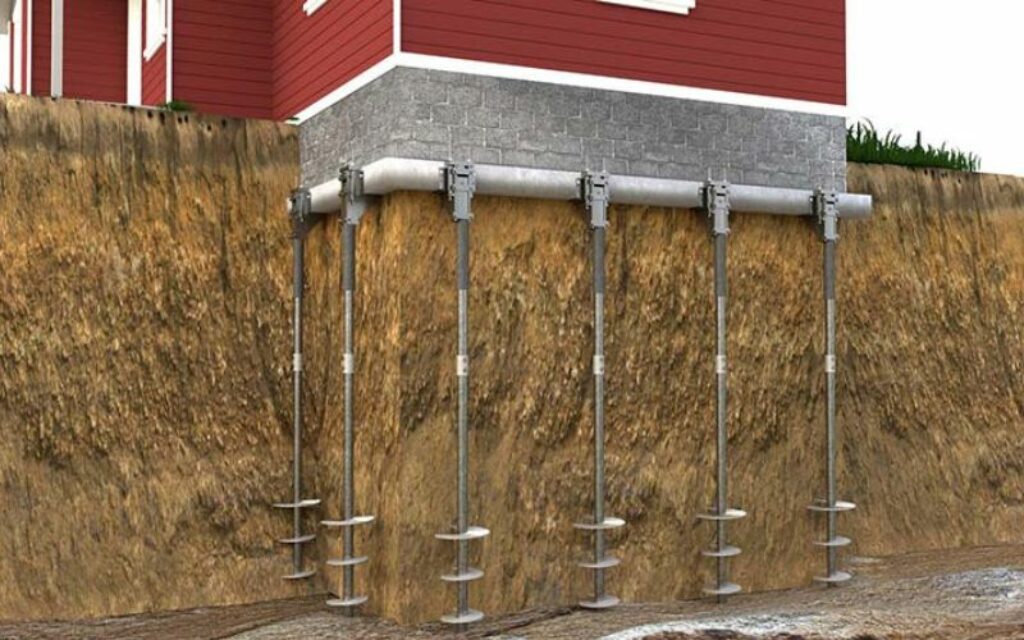Helical piers are an innovative and effective way to repair a foundation needing stabilization or support. These piers look similar to a ship’s screw and provide structural stability for your home’s foundation.
The pier is installed using specialized machinery into the soil below the foundation and then secured with steel plates at both ends, providing adequate support for the building above. This type of pier installation can be used on any type of soil and is stronger than traditional concrete footers.
Helical piers provide deep foundations, ensuring that your foundation will be secure even if there is movement below due to changes in the water table or soil conditions.
They also act as anchors, anchoring your structure securely into the ground so that it doesn’t shift or move over time. Helical piers are also suitable for buildings with expansive soils, which can cause problems with foundation stability due to their high propensity to expand and contract.

Helical piers are an effective option for foundation repair as they provide a permanent solution that is cost-effective and energy efficient. The installation process is relatively quick, and the equipment required is smaller than traditional methods, making it easier to access tight areas around homes. This foundation repair method can be used in residential, commercial, and industrial applications as long as there is adequate soil-bearing capacity.
It also has a minimal environmental impact since no large excavations, or concrete footers are required like other foundation repair methods. Here are ten common problems helical piers are used to solve.
1. Insufficient soil support: One of the most common problems that helical piers are used to solve is settling foundations due to insufficient soil support beneath them. With soil becoming increasingly compact due to urbanization and other factors, many structures become unstable over time. Helical piering is one way to help stabilize a structure’s foundation by providing additional support deep underneath it, thereby preventing further settling and potential damage.
2. Erosion Damage: Helical piers are also used to repair foundations damaged by erosion, flooding, or other forces of nature, such as earthquakes. By providing added support beneath the foundation, helical piers can help stabilize a structure while repairs to its existing foundation are made. This piering is often used in areas with high water tables and unstable soils, such as coastal regions prone to storm surges and floods.
3. Retrofitting existing structures: Another common use for helical piers is to retrofit existing structures with new foundations when their existing ones are no longer able to support their load adequately. For example, if a business expands its operations by adding more weighty assets, such as heavy machinery, it may be necessary to upgrade its existing foundation with helical piers to prevent sinking or other structural damage.
Also Read: Things you can do to ensure that your foundation remains strong throughout the year
4. New Construction: Helical piers are also used in new construction projects, particularly when building on challenging or unstable soil. The added support can help prevent settling and protect structures from potential damage down the road by installing helical piers beforehand. This is especially important in areas where earthquakes are more common, as helical piers can provide extra stability during ground shaking.
5. Slabjacking: In some cases, instead of replacing a structure’s entire foundation, a more cost-effective solution can be found through slabjacking. This method involves using specialized injectable grout to fill any voids in the soil beneath concrete slabs, helping to raise and re-level them without completely replacing them. Helical piers are often used as anchors for this process, providing additional stability and support while the slab is jacked up.
6. Underpinning: When an existing foundation cannot support its load due to settling or other issues, underpinning may be necessary. This process typically involves excavating underneath an existing foundation and installing deep steel piles into stable soil layers to provide additional support. Helical piers can also be used for this, offering greater stability and longevity than more traditional underpinning methods.
7. Foundation Lifting: When a structure’s foundation has settled due to soil compression or erosion, lifting it can help restore its integrity and prevent further damage. Helical piers are often used because they provide the added strength and stability needed to lift a heavy structure without causing additional settling or other issues. This is especially helpful in areas prone to flooding or seismic activity, where extra protection from movement is necessary.
8. Seismic Retrofitting: Earthquake-prone areas require buildings with strong foundations that can withstand ground shaking with minimal disruption. Helical piers can provide the extra support needed to help meet this requirement. By installing helical piers as part of a seismic retrofitting project, buildings will be better equipped to withstand powerful earthquakes and prevent costly damage or destruction.
9. Slope Stabilization: When the soil on a slope is unable to support its weight, landslides and other forms of ground movement can occur. Helical piers are often used in these situations, providing deeper levels of stability when more traditional methods are insufficient. By anchoring into stable soil layers beneath the surface, they can help mitigate potential landslide risks while allowing regular plant growth and activity on the slopes above.
10. Tieback Anchors: In cases where a building or structure needs to be stabilized during excavation, helical tieback anchors can provide the necessary support. These consist of specially designed helical piers installed at an angle into the soil to transfer tension loads away from a wall and into the stable ground below. When used properly, they can help ensure that structures remain secure and intact while excavation occurs nearby.
Overall, helical piers are highly versatile tools with many applications in residential and commercial construction projects. From retrofitting existing foundations to providing extra stability for new builds, these special piers offer powerful solutions no matter what project you tackle. With their ability to reach deeper levels of stability than traditional methods, they are becoming increasingly popular for their ease of use and reliability.